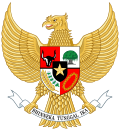This article has multiple issues. Please help improve it or discuss these issues on the talk page . (Learn how and when to remove these messages)
|
| This article is part of a series on the |
| Politics of Indonesia |
|---|
 |
US$43 billion in International Monetary Fund (IMF) aid in 2003 was sent as foreign aid to Indonesia, and this assistance has traditionally been an important part of the central government's budget. [1]
Contents
- Multilateral aid
- 2004 Indian Ocean earthquake
- Bilateral aid
- China
- Australia
- Japan
- United States
- Election support
- See also
- References
From 1967 to 1991, most aid was coordinated through the Inter-Governmental Group on Indonesia (IGGI), founded and chaired by the Netherlands; since 1992, without the Netherlands, the organization has been known as the Consultative Group on Indonesia (CGI). [1]
Although Indonesia terminated its IMF aid program in December 2003, it still receives bilateral aid through the CGI, which pledged US$2.8 billion in grants and loans for 2004. [1] Japan and the Asian Development Bank also have been key donors. [1]